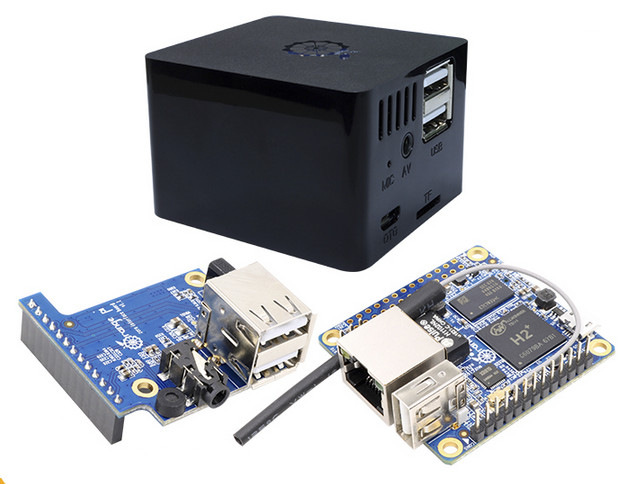Since Google released the Google Assistant SDK for Raspberry Pi 3, and other ARMv7 boards, I thought I should it try myself on one of the tiny headless boards I have, as you just need audio output and a microphone. I first planed to use NanoPi NEO board with NanoHAT PCM5102A audio board, a cheap USB microphone, and pair of speakers, but this morning, I’ve come across Orange Pi Zero Set 6 kit that looks perfect for this applications and sells for just $12.95 plus shipping ($18.27 in total for me) with Orange Pi Zero board, Orange Pi Zero interface board, and a case.
Orange Pi Zero board is powered by Allwinner H2+ quad core Cortex A7 processor with 512MB RAM, and can run the required Ubuntu/Debian distribution using one of the Armbian images, and connected to the Internet over Ethernet or WiFi, however if you want to use the latter, be aware that stability and performance issues have been reported.
Microphone and audio output are added using Orange Pi Zero Interface Board V1.1 which adds one built-in microphone, and a 3.5mm audio jack where you should be able to connect your speakers. You’ll also get two extra USB host ports.
All you need to complete the hardware setup is a micro SD card, a pair of speakers, and a USB power supply. I’ve seen some demo requiring that you press a button before speaking. That will not be possible with this kit unless you add some button connected through USB or GPIO, but hopefully it’s possible to use the “hot word” technique to avoid adding that extra button.
The instructions on Google developer website for ARM boards seem clear enough, but since Aliexpress lists over 3,000 orders for that “Set 6” kit, I assumed somebody already tried that and wrote some specific instructions. Sadly, I had no luck finding such instructions, but I noticed somebody did something similar with Orange Pi PC board that includes a microphone and audio jack, and he uses a jar as an enclosure.
Ficus Online also posted the instructions on his blog, where he explains how to use a hotword too, so in theory you would not need any button. You may want to check their full website, as they use this Smart Jar as a home automation gateway with other purposes than just Google Assistant. If alternatively, you have some 96Boards on hand, there’s a specific Google Assistant project being worked on. If you prefer Amazon Alexa, there’s a project for Orange Pi + Alexa on Github, but it has not been updated for a year.

Jean-Luc started CNX Software in 2010 as a part-time endeavor, before quitting his job as a software engineering manager, and starting to write daily news, and reviews full time later in 2011.
Support CNX Software! Donate via cryptocurrencies, become a Patron on Patreon, or purchase goods on Amazon or Aliexpress





